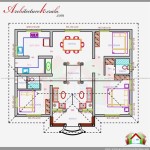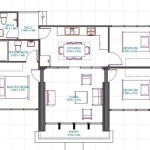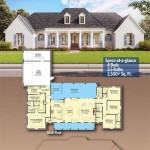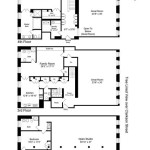Building Plan for a House: A Comprehensive Guide
A building plan for a house is a crucial document that outlines the structural details, design elements, and spatial arrangements of your future home. It acts as a blueprint for construction, ensuring that the finished product meets your specific requirements and aesthetic preferences. Creating a comprehensive building plan involves meticulous planning, careful consideration of various factors, and collaboration with professionals. This article will delve into the essential aspects of developing a well-structured building plan for your house.
1. Defining Your Needs and Requirements
Before embarking on the design process, it is essential to clearly define your needs and requirements for your new home. This includes considering the following factors:
- Number of bedrooms and bathrooms: Determine the ideal number of rooms based on your family size and lifestyle.
- Living space: Consider the size and layout of living areas, such as the living room, dining room, and kitchen, according to your entertainment and social needs.
- Outdoor space: Define your desired outdoor living areas, such as a patio, garden, or balcony, and their integration with the overall design.
- Special requirements: Account for any specific requirements, such as wheelchair accessibility, home office space, or a dedicated play area for children.
- Budget: Establish a realistic budget for the construction project, considering the cost of materials, labor, and permits.
By carefully outlining your needs and requirements, you provide a solid foundation for the subsequent planning stages.
2. Architectural Design and Layout
The architectural design and layout of your building plan play a pivotal role in defining the overall aesthetics and functionality of your home. This phase involves working closely with an architect or experienced designer to create a plan that aligns with your vision. Key considerations include:
- Style and aesthetics: Determine the architectural style that best suits your taste and preferences, whether it's contemporary, traditional, or a blend of various elements.
- Floor plan: Create a detailed floor plan that optimizes space utilization and flow between different rooms. This includes defining the size and placement of each room, as well as the location of doors, windows, and staircases.
- Exterior design: Plan the exterior design, including the facade, roofline, and landscaping, ensuring it harmonizes with the overall architectural style and your neighborhood aesthetics.
- Sustainability features: Integrate sustainable design features, such as energy-efficient windows, solar panels, or rainwater harvesting systems, to minimize environmental impact and maximize energy savings.
The architectural design and layout should be meticulously crafted to create a comfortable, functional, and visually appealing space that meets your specific needs.
3. Structural Engineering and Building Codes
Once the architectural design is finalized, it is crucial to consult with a structural engineer to ensure the house's structural integrity and compliance with local building codes. The structural engineer will perform calculations and develop drawings for the foundation, walls, roof, and other structural elements. Key aspects of this phase include:
- Foundation design: The foundation is the bedrock of your house, supporting the entire structure. The engineer will determine the appropriate type of foundation based on soil conditions, seismic activity, and other site-specific factors.
- Wall systems: The engineer will specify the type of wall construction, considering factors such as load-bearing capacity, energy efficiency, and fire resistance.
- Roof design: The roof design should be structurally sound, capable of supporting the weight of the roof covering, snow load, and wind pressure. The engineer will consider factors such as roof pitch, material choice, and ventilation.
- Building codes: The engineer will ensure that the building plan complies with all applicable local building codes, which address safety standards, accessibility requirements, and other regulations.
Structural engineering plays a critical role in ensuring the safety and stability of your home, making it crucial to work closely with qualified professionals in this field.
4. Mechanical, Electrical, and Plumbing Systems
The design and implementation of mechanical, electrical, and plumbing systems (MEP) are integral to the functionality and comfort of your house. This phase involves collaboration with MEP engineers to plan and integrate these systems seamlessly within the overall building plan. Important aspects include:
- Heating, ventilation, and air conditioning (HVAC): The HVAC system provides heating, cooling, and ventilation for your home. The MEP engineer will design the system, considering factors such as climate, insulation levels, and energy efficiency.
- Electrical system: The electrical system provides power to your house's appliances, lighting, and other electrical components. The engineer will determine the layout of electrical circuits, the size of electrical panel, and the placement of outlets, switches, and fixtures.
- Plumbing system: The plumbing system includes water supply, drainage, and waste disposal. The MEP engineer will design the system, considering factors such as water pressure, fixture types, and the location of water heaters, sinks, and toilets.
MEP systems should be carefully planned and integrated to ensure optimal performance and efficiency, creating a comfortable and functional living environment.
5. Construction Drawings and Specifications
The final stage of developing a building plan involves creating detailed construction drawings and specifications that serve as a blueprint for the construction process. These documents provide precise instructions for the builder, ensuring that the house is constructed according to the approved design. Key elements of this phase include:
- Architectural drawings: These drawings provide a comprehensive visual representation of the building's design, including floor plans, elevations, sections, and details.
- Structural drawings: These drawings show the details of the structural elements, including the foundation, walls, roof, and beams.
- MEP drawings: These drawings outline the layout of mechanical, electrical, and plumbing systems, including ductwork, wiring, and plumbing lines.
- Specifications: Specifications provide detailed descriptions of materials, finishes, and construction methods, ensuring consistency throughout the project.
Creating comprehensive construction drawings and specifications is essential for effective communication between the architect, engineer, builder, and other project stakeholders. This ensures that the house is built according to the approved design and that all requirements are met.

Home Plans Building Design At 10 Sq Ft In New Delhi Id 2854425134555

6 Y Residential Building Plans And Section Two Bedrooms Per Unit

Design Your Own House Floor Plans Roomsketcher

Create 3d Floor Plans With Roomsketcher

Home Plan House Designers In Bangalore Buildingplanner

Design Your Own House Floor Plans Roomsketcher

Parts Of A Building Plan Ck

Easy Home Building Floor Plan Cad Pro

1200 Sq Ft Floor Plan 2 Bedroom 2bedroom House Building Plans Designs And Books

Easy To Build Houses And Floor Plans Houseplans Blog Com








